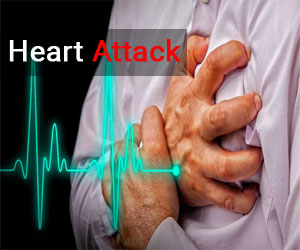- Home
- Editorial
- News
- Practice Guidelines
- Anesthesiology Guidelines
- Cancer Guidelines
- Cardiac Sciences Guidelines
- Critical Care Guidelines
- Dentistry Guidelines
- Dermatology Guidelines
- Diabetes and Endo Guidelines
- Diagnostics Guidelines
- ENT Guidelines
- Featured Practice Guidelines
- Gastroenterology Guidelines
- Geriatrics Guidelines
- Medicine Guidelines
- Nephrology Guidelines
- Neurosciences Guidelines
- Obs and Gynae Guidelines
- Ophthalmology Guidelines
- Orthopaedics Guidelines
- Paediatrics Guidelines
- Psychiatry Guidelines
- Pulmonology Guidelines
- Radiology Guidelines
- Surgery Guidelines
- Urology Guidelines
Practical Tips to successfully resume work after a heart attack

It is your willpower that decides how successfully one can resume his work after a heart attack. Heart attack patients with the desire to return to work can do it. However, there may be certain precautions to be observed and a stepwise approach may benefit in this matter. That's the main message of a paper published today in the European Journal of Preventive Cardiology, a journal of the European Society of Cardiology (ESC).
The probability of returning to work depends mainly on the patient's decision - do they want to go back or not? Next are psychological factors, with lack of confidence, depression and anxiety all predicting failure to return. The patient's medical condition combined with the type of work can also have an impact.
About 67% to 93% of patients with acute coronary syndromes - which include heart attack and unstable angina (chest pain) - return to work in two to three months. But after a year, one in four quit. Among those over 55, women are less likely to go back to employment than men. This paper outlines the reasons and gives practical advice on how to successfully reintegrate into the workplace.
Tips for a successful resume work after heart attack:
- Attend cardiac rehabilitation (half of the eligible patients don't) for advice on a healthy lifestyle, plus personalised tips from a cardiologist, psychologist, physiotherapist, social worker, and occupational therapist on getting back into employment.
- Don't change jobs.
- Take it gradually if needed: do fewer hours/days at the start, work from home once a week, take more breaks, delegate some responsibility.
- Stay in contact with your GP and/or company doctor and adjust the workload if needed.
"Patients who believe they can still do their job and want to go back will make a success of it," said lead author Dr Rona Reibis, of the University of Potsdam, Germany. "After a heart attack, it is very rare for patients to be physically unable to perform their previous duties, including heavy work."
Blue collar workers may struggle if they have heart failure, rhythm instability, or ischaemia which reduce physical performance. Those with implanted cardiac devices might need to avoid workplaces with electrical fields.
As for gender differences, Dr Reibis said: "There is still the traditional idea that the man must go back to work because he is the breadwinner. Whereas women can be reintegrated but it depends on whether they want to. Added to that, women tend to have more doubts about their ability to perform their prior tasks - particularly blue-collar roles. Well educated women with white collar jobs don't have this problem."
Similarly, blue-collar workers with lower education and socioeconomic levels are more likely to quit after one year. This is particularly true for patients in their 30s who smoke and are overweight or obese.
"The best way is to return to the job you know," said Dr Reibis. "Patients who had a relatively small heart attack with complete restoration of blood flow, are consistently taking their medication and don't have an implanted device can do their work as before without any precautions."
"Others may wish to ease back into their former role," she continued. "During the first couple of months if you are not able to keep up with the workload, change it. Don't wait until it becomes unmanageable and you have to quit. And try to reduce stress, for example by giving up some responsibilities for half a year."
Regarding follow-up after resuming work, patients who have no signs of depression or anxiety, feel positive about their ability to work and can meet the physical requirements don't need specific follow-up advice. Further observation is needed for those with work-related problems - typically middle-aged male blue-collar workers with low education and a high burden of comorbidities such as obesity, smoking, and diabetes.
"Such patients need continuous input with coping strategies and support," said Dr Reibis. "For example, they can do a longer programme of cardiac rehabilitation. It is very important that they maintain contact with their GP or company doctor and modify the tasks as needed."
The paper was written by the Secondary Prevention and Rehabilitation Section, European Association of Preventive Cardiology (EAPC) of the ESC. It is published during the EAPC's annual congress EuroPrevent.
For more details click on the link: http://dx.

Disclaimer: This site is primarily intended for healthcare professionals. Any content/information on this website does not replace the advice of medical and/or health professionals and should not be construed as medical/diagnostic advice/endorsement or prescription. Use of this site is subject to our terms of use, privacy policy, advertisement policy. © 2020 Minerva Medical Treatment Pvt Ltd